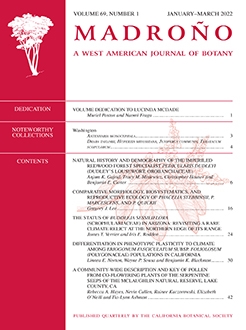As wildfires increase in extent and intensity and threaten local communities, active suppression tactics are becoming more common, including the creation of fire lines. Post-fire, these sites can become populated with non-native species and risk type conversion if native species recovery is lacking. Minimal research exists on the plant community trajectory of these mechanically disturbed sites. We studied the 32-Fire located east of Chico, CA. A fire line approximately 0.5 km long ranging in width from 6–12.2 m was created by a bulldozer. To assess plant recovery, we established plots in three pre-fire vegetation types: California Black Oak (Quercus kelloggii Newb.), Manzanita (Arctostaphylos manzanita Parry), and Wedgeleaf Ceanothus (Ceanothus cuneatus [Hook.] Nutt.) within three disturbance levels: burned, unburned (reference), and disturbed dozer line. Sites were sampled in 2018 (six-months post-fire) and in 2019 (18-months post-fire). In 2019, dozer line sites in the Manzanita and Wedgeleaf Ceanothus vegetation types did not have the dominant species found in similar unburned or burned sites. Across all vegetation types, dozer line sites had significantly higher average percent non-native species cover, compared with respective burned (P < 0.001, 95% C.I. = 33.2, 64.8) and unburned areas (P < 0.001, 95% C.I. = -77.2, -45.5). While unburned Wedgeleaf sites average non-native cover was 11% (SD = 9) in 2018 and 20% (SD = 5) in 2019, Wedgeleaf dozer line sites average non-native cover remained high between survey years at approximately 85%. Manzanita dozer line sites had average nonnative cover of 76% (SD = 16) and 57% (SD = 25) in 2018 and 2019, respectively, while unburned Manzanita had 9% (SD = 9) and 16% (SD = 16). Manzanita and Wedgeleaf Ceanothus species present on the study site are obligate seeders. Since neither species survived the implementation of the dozer line and no new recruitment of these species was observed, future recruitment of obligate seeders in these areas is unlikely. This suggests that dozer line sites with obligate seeders as dominant or co-dominant species are at risk of type conversion from native chaparral to annual grasslands dominated by non-native species.
How to translate text using browser tools
21 April 2022
DOZER LINES INFLUENCE POST-FIRE PLANT COMMUNITY RECOVERY
Hannah S. Weinberger,
Kristen M. Kaczynski
ACCESS THE FULL ARTICLE

Madroño
Vol. 69 • No. 1
January–March 2022
Vol. 69 • No. 1
January–March 2022
fire line
Fire management
fuels
invasive plants
non-native plants
Obligate seeder
Resprouter




